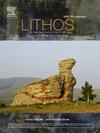The mobilization of trace elements in apatite during metamorphic recrystallization: A record from the Huangmailing metamorphosed phosphorite, Hubei Province, Central China
IF 2.9
2区 地球科学
Q2 GEOCHEMISTRY & GEOPHYSICS
引用次数: 0
Abstract
The chemical composition of apatite provides reliable constraints on petrogenetic processes. However, the behavior of apatite and the redistribution of elements during the metamorphism of phosphorite, a unique sedimentary rock type, remain unclear. This study presents textural, in situ U![]() Pb geochronology, trace and rare earth elements, and Sr isotope data for apatite from the Huangmailing metamorphosed phosphorite in Hubei Province, Central China. Four distinct metamorphic phosphorite samples were collected, namely, dolomitic phosphorite, black massive phosphorite, quartz-muscovite-bearing phosphorite, and quartz-muscovite-bearing phosphorite, with different mineral assemblages. We distinguished four types of apatite based on the mineral assemblage. Type 1 apatite occurred as a layer and interbedded with kutnohorite. In contrast, type 2 apatite is associated with the crumpled K-feldspar band, and type 3 apatite is commonly associated with quartz, muscovite, and calcite. Type 4 apatite is distinct from the other three types of apatite, which is characterized by larger grain size and associated with muscovite and monazite. Precise U
Pb geochronology, trace and rare earth elements, and Sr isotope data for apatite from the Huangmailing metamorphosed phosphorite in Hubei Province, Central China. Four distinct metamorphic phosphorite samples were collected, namely, dolomitic phosphorite, black massive phosphorite, quartz-muscovite-bearing phosphorite, and quartz-muscovite-bearing phosphorite, with different mineral assemblages. We distinguished four types of apatite based on the mineral assemblage. Type 1 apatite occurred as a layer and interbedded with kutnohorite. In contrast, type 2 apatite is associated with the crumpled K-feldspar band, and type 3 apatite is commonly associated with quartz, muscovite, and calcite. Type 4 apatite is distinct from the other three types of apatite, which is characterized by larger grain size and associated with muscovite and monazite. Precise U![]() Pb isotope data for type 1 and 2 apatite were obtained to constrain the metamorphic age of the sedimentary phosphorite, which ranged from 218 ± 6.4 Ma to 214.9 ± 9.6 Ma. Compared with the apatites from the unmetamorphosed phosphorite in south China, the studied apatites are commonly enriched with rare earth elements and yttrium (REY) (except type 3 apatite) but depleted in Ba. These four types of apatite have different trace and rare earth element compositions, especially their REY patterns. The lower (La/Sm)N of type 1 apatite than that of type 2 to 3 apatite may suggest the mobilization of light rare earth element (LREE) in type 1 apatite into the metamorphic fluid. A slightly positive Eu anomaly was observed for the type 2 apatite, suggesting the contribution of dissolved K-feldspar during the metamorphic recrystallization of type 2 apatite. The REY patterns of type 3 apatite differ slightly from those of primary apatite, whereas type 4 apatite presents distinct REY patterns in comparison with the other three types of apatite, with an obvious negative Eu anomaly and the highest LREE content. These findings suggest that the enrichment of Sr and the slightly positive Eu anomalies in type 2 apatite can be linked to the breakdown of K-feldspar during metamorphic reactions. This connection is supported by the comparatively elevated Sr isotopic composition of type 2 apatite. As muscovite and monazite decomposed, the released Th, Pb, Na, and LREEs were incorporated into type 4 apatite. The newly reported data from this study prove that the composition of apatite changes during metamorphism, depending on the local mineral assemblage. The trace elements released from associated minerals may be incorporated into apatite during metamorphic recrystallization, leading to diversity in the chemical signatures of apatite.
Pb isotope data for type 1 and 2 apatite were obtained to constrain the metamorphic age of the sedimentary phosphorite, which ranged from 218 ± 6.4 Ma to 214.9 ± 9.6 Ma. Compared with the apatites from the unmetamorphosed phosphorite in south China, the studied apatites are commonly enriched with rare earth elements and yttrium (REY) (except type 3 apatite) but depleted in Ba. These four types of apatite have different trace and rare earth element compositions, especially their REY patterns. The lower (La/Sm)N of type 1 apatite than that of type 2 to 3 apatite may suggest the mobilization of light rare earth element (LREE) in type 1 apatite into the metamorphic fluid. A slightly positive Eu anomaly was observed for the type 2 apatite, suggesting the contribution of dissolved K-feldspar during the metamorphic recrystallization of type 2 apatite. The REY patterns of type 3 apatite differ slightly from those of primary apatite, whereas type 4 apatite presents distinct REY patterns in comparison with the other three types of apatite, with an obvious negative Eu anomaly and the highest LREE content. These findings suggest that the enrichment of Sr and the slightly positive Eu anomalies in type 2 apatite can be linked to the breakdown of K-feldspar during metamorphic reactions. This connection is supported by the comparatively elevated Sr isotopic composition of type 2 apatite. As muscovite and monazite decomposed, the released Th, Pb, Na, and LREEs were incorporated into type 4 apatite. The newly reported data from this study prove that the composition of apatite changes during metamorphism, depending on the local mineral assemblage. The trace elements released from associated minerals may be incorporated into apatite during metamorphic recrystallization, leading to diversity in the chemical signatures of apatite.
求助全文
约1分钟内获得全文
求助全文
来源期刊

Lithos
地学-地球化学与地球物理
CiteScore
6.80
自引率
11.40%
发文量
286
审稿时长
3.5 months
期刊介绍:
Lithos publishes original research papers on the petrology, geochemistry and petrogenesis of igneous and metamorphic rocks. Papers on mineralogy/mineral physics related to petrology and petrogenetic problems are also welcomed.
 求助内容:
求助内容: 应助结果提醒方式:
应助结果提醒方式:


